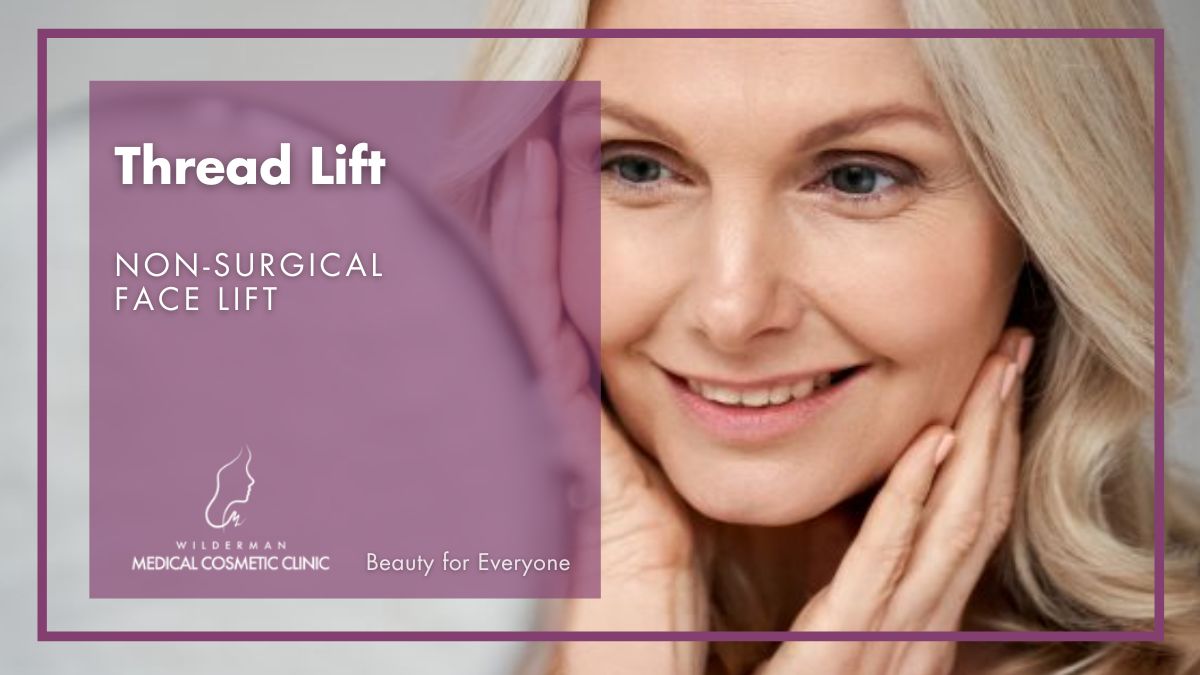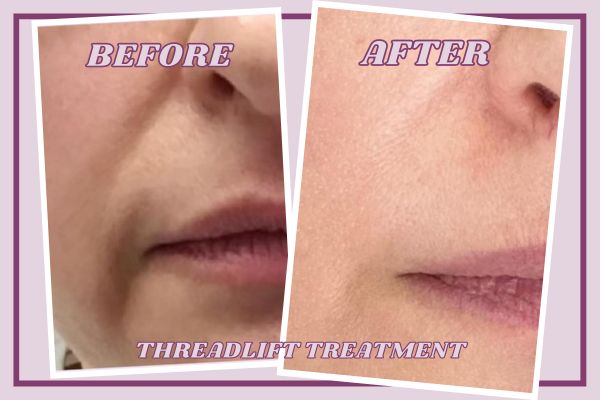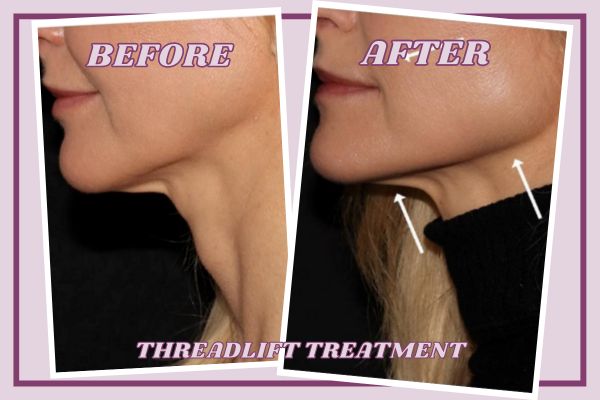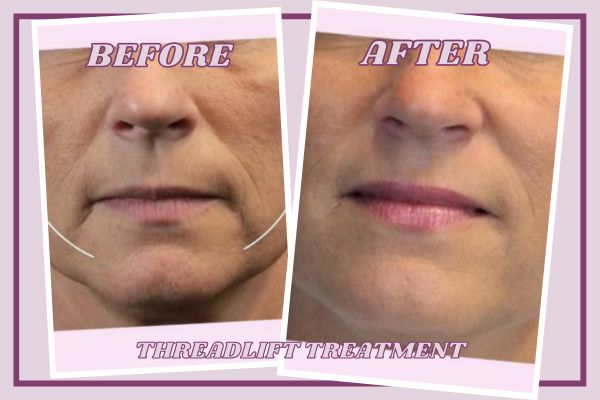Thread Lift
Non surgical face lift
Thread lift is a minimally invasive cosmetic procedure designed to lift and rejuvenate sagging or aging facial and neck skin. Unlike traditional facelift surgeries that involve extensive incisions and downtime, Thread Lift offers a non-surgical solution for individuals seeking facial rejuvenation.
This innovative technique utilizes dissolvable sutures or threads inserted under the skin to lift and tighten specific areas of the face.
Thread lift uses advanced Micro-Suspension Technology to give uplifting results. Threads have become a popular non-surgical alternative for lifting and tightening the skin. They not only work by physically lifting sagging skin but also by stimulating the body’s natural healing response. The increased collagen production achieved with this treatment not only helps to lift and tighten the skin but also combats the signs of aging by rejuvenating your skin from within.

Get immediate answers to your questions about treatment options, costs, expected outcomes, and more.
- Expert Diagnosis
- Customized Treatment Plans
- No Obligation
- Comfort and Privacy
- Immediate Answers
One of the significant advantages of Thread Lift is its minimal invasiveness. The procedure is typically performed in a clinic setting under local anesthesia, and you can resume your normal activities relatively quickly after the treatment.
Additionally, Thread lift results in less bruising and swelling compared to traditional facelift surgeries, making it a popular choice for individuals who want to achieve a more youthful appearance without the extended recovery period.
Thread lift is suitable for individuals experiencing mild to moderate signs of aging and seeking subtle improvements in facial contour and firmness. However, it’s essential for patients considering Thread Lift to consult with a qualified and experienced practitioner.
A skilled professional can assess the patient’s specific concerns, discuss realistic expectations, and create a personalized treatment plan to achieve the desired results.
Are you a good candidate?
Thread Lift, like any medical procedure, is not suitable for everyone. Some specific factors and conditions may make individuals unsuitable candidates for this treatment. People who should not go for the Thread Lift procedure typically include:
- People with bleeding disorders or those taking blood-thinning medications may not be suitable candidates for Thread Lift due to the increased risk of bleeding and bruising.
- Women who are pregnant or breastfeeding are generally advised to postpone cosmetic procedures, including Thread Lift, until after they have completed this phase.
- Individuals with active skin infections, inflammations, or any open wounds should not undergo Thread Lift until the skin has fully healed.
- Individuals with known allergies to the materials used in the threads or sutures (such as polydioxanone) should avoid Thread Lift procedures to prevent allergic reactions.
- People with autoimmune disorders or conditions that affect the body’s healing process and immune response may not be ideal candidates for Thread Lift. These conditions can affect the body’s ability to heal properly after the procedure.
- Patients with unrealistic expectations about the outcomes. It’s essential for individuals to have a clear understanding of what Thread Lift can achieve and to have reasonable expectations regarding the results.
- Thread Lift is most effective for individuals with mild to moderate skin laxity. Patients with severe sagging or excess skin may not achieve the desired results with Thread Lift alone and might require more invasive surgical procedures for optimal outcomes.
- Individuals who do not receive medical clearance from their healthcare provider or cosmetic surgeon should not undergo Thread Lift. A thorough medical evaluation is essential to ensure the patient’s overall health and suitability for the procedure.
It’s crucial for anyone considering Thread Lift or any cosmetic procedure to consult with a qualified and experienced medical professional. A consultation allows the practitioner to assess the patient’s specific needs, medical history, and suitability for the procedure, ensuring that the treatment is safe and appropriate for the individual.
For whom would this treatment be suitable?
Thread Lift can be suitable for individuals in their late 30s to early 50sexperiencing mild to moderate signs of facial aging and seeking non-surgical solutions for facial rejuvenation. People with the following concerns may be candidates for the Thread Lift procedure:
Mild to moderate skin laxity: Thread Lift is effective for individuals with mild to moderate skin laxity, particularly in areas such as the cheeks, jowls, and neck. It can help lift and tighten sagging skin, providing a more youthful appearance.
Fine lines and wrinkles: Thread Lift can be used to target fine lines and wrinkles, especially around the eyes, mouth, and forehead. By lifting and tightening the skin, Thread Lift can reduce the appearance of these lines.
Facial sagging: Individuals experiencing sagging in the midface, lower face, or neck can benefit from Thread Lift. The procedure can help reposition sagging tissues, restoring a more youthful facial contour.
Nasolabial folds: Thread Lift can address nasolabial folds, which are the lines that run from the sides of the nose to the corners of the mouth. By lifting the skin in this area, Thread Lift can soften the appearance of these folds.
Jowls: Thread Lift can lift and tighten the skin in the jowl area, reducing the prominence of jowls and restoring a more defined jawline.
Facial volume loss: While not a replacement for dermal fillers, Thread Lift can provide subtle volume enhancement by lifting sagging skin, which can improve the appearance of areas affected by volume loss.
Benefits of Thread Lift
- Non-surgical and minimally invasive: Thread Lift is a non-surgical procedure, meaning it doesn’t involve extensive incisions or general anesthesia. It is minimally invasive and performed with local anesthesia, reducing the risks and downtime associated with traditional facelift surgery.
- Quick procedure: Thread Lift can often be completed within an hour, making it a convenient option for individuals with busy schedules. The relatively short procedure time means patients can often undergo treatment during a lunch break or in between daily activities.
- Minimal downtime: Unlike surgical facelifts, which require significant recovery time, Thread Lift usually involves minimal downtime. Patients can typically resume their regular activities shortly after the procedure, although some minor swelling and bruising may occur, which usually subside within a few days to a week.
- Natural-looking results: Thread Lift provides subtle and natural-looking results. Lifting and repositioning sagging skin restores a more youthful facial contour without creating an overdone or “pulled” appearance.
- Stimulates collagen production: Thread Lift not only provides an immediate lifting effect but also stimulates the production of collagen, a protein that enhances skin elasticity and firmness. Natural collagen production helps improve skin texture and tone over time, contributing to a more youthful appearance.
- Customizable treatment: Thread Lift is a versatile procedure that can be customized to address specific areas of concern, such as the cheeks, jowls, neck, or brow. The procedure can be tailored to meet the individual needs and goals of the patient.
- Safe and FDA-approved materials: The threads used in Thread Lift procedures are typically made from biocompatible materials like polydioxanone (PDO), which are safely absorbed by the body over time. These materials have been approved by regulatory authorities, such as the FDA, ensuring their safety and efficacy.
- Long-lasting results: While Thread Lift results are not permanent, they can last for several months to a few years, depending on the type of threads used and individual factors. Some patients may opt for touch-up procedures to maintain the results over time.
It’s important to note that the effectiveness and longevity of Thread Lift results can vary from person to person. Consulting with a qualified and experienced medical professional is essential to determine if Thread Lift is a suitable option based on individual goals and concerns.
What are the precautions that need to be taken?
Thread Lift is a minimally invasive procedure, but like any medical intervention, it requires certain precautions to ensure the safety and effectiveness of the treatment. Here are some precautions that should be considered:
- Choose a certified and experienced practitioner who is skilled in performing Thread Lift procedures.
- Provide a comprehensive medical history to your practitioner, including any allergies, previous cosmetic procedures, ongoing medications, and medical conditions.
- If possible, avoid blood-thinning medications and supplements before the procedure.
- Follow the post-procedure care instructions provided by your practitioner diligently. This may include avoiding certain activities, skincare products, or makeup for a specific period after the procedure to promote proper healing.
- If you experience any unusual symptoms, such as excessive swelling, pain, or signs of infection (like redness or pus), contact your practitioner immediately.
- Follow-up appointments should be scheduled to monitor progress and address any concerns they might have after the procedure.
Are there any side effects?
Yes, like any cosmetic procedure, Thread Lift can have potential side effects. While many patients do not experience severe side effects, it’s essential to be aware of the possible reactions that can occur. These side effects are usually temporary and subside within a few days to a couple of weeks.
Common side effects of Thread Lift may include:
- Swelling: Mild to moderate swelling at the treatment site is common and typically subsides within a few days. Keeping the head elevated and applying cold compresses can help reduce swelling.
- Bruising: Bruising at the insertion points of the threads is a common side effect. The bruising usually resolves within a week or two. Avoiding blood-thinning medications and supplements before the procedure can help minimize bruising.
- Discomfort or pain: Some patients may experience mild discomfort, tenderness, or pain at the insertion points. Over-the-counter pain relievers can help manage these symptoms.
- Redness: Temporary redness or skin irritation at the insertion sites can occur. This usually resolves on its own within a few days.
- Numbness or tingling: Patients might experience numbness or tingling sensations in the treated area, which typically resolve as the skin heals.
- Visible or palpable threads: In some cases, patients might be able to feel the threads under the skin, especially during the initial healing period. Visible threads are rare but can occur. These issues can often be adjusted or corrected by the practitioner.
- Infection: Although rare, there is a risk of infection at the insertion points. Signs of infection include increased redness, swelling, pain, or discharge. If these symptoms occur, it’s crucial to contact the healthcare provider promptly.
- Uneven results: Achieving perfect symmetry is challenging, and minor asymmetry might occur. Skilled practitioners aim for natural-looking results, but slight unevenness can happen.
- Allergic reactions: Although rare, some individuals might have an allergic reaction to the materials used in the threads. It’s essential for patients to disclose any known allergies to the practitioner before the procedure.
- Puckering or dimpling: In some cases, the skin might appear slightly puckered or dimpled at the insertion points. This is usually temporary and resolves as the threads settle.
How does Thread Lift work?
Threads lift and stimulate collagen for skin tightening
The Thread Lift procedure involves the insertion of dissolvable threads under the skin. These threads, often made of materials like polydioxanone (PDO), have tiny barbs or cones that grip the skin.
A practitioner inserts the threads into the subcutaneous tissue of the skin using thin needles or cannulas. The threads are strategically placed to target specific areas of sagging or aging.
The threads have barbs or cones that grasp the skin, allowing the practitioner to gently lift and reposition sagging skin tissues. This immediate lifting effect provides visible results during the procedure itself.
Over time, the presence of threads under the skin stimulates the body’s natural wound-healing response. This response includes increased collagen production, a vital protein responsible for skin elasticity and firmness.
As collagen production increases, the skin gradually tightens and becomes more supple. This natural skin rejuvenation process occurs as the body generates new collagen around the threads, enhancing skin texture and tone.
The new collagen fibers continue to support the skin even after the threads have dissolved. This ongoing collagen renewal sustains the improved skin tightness and firmness, providing long-term results.
Thread Lift mechanism involves immediate lifting and repositioning of sagging skin, followed by the stimulation of collagen production. This dual action results in visible improvements in skin tightness, texture, and overall facial rejuvenation, with the effects becoming more pronounced over time as the body naturally produces new collagen.
What are the different types of materials used to make the thread?
Several materials are used to make threads for Thread Lift procedures. The choice of material can influence the longevity and effectiveness of the procedure. Some common types include:
- Polydioxanone (PDO): PDO threads are absorbable and stimulate collagen production. They are commonly used in Thread Lift procedures and gradually dissolve within several months.
- Poly-L-Lactic Acid (PLLA): PLLA threads stimulate collagen synthesis and are often used for longer-lasting results. They dissolve over a more extended period and provide gradual skin tightening.
- Polycaprolactone (PCL): PCL threads promote collagen production and have a longer-lasting effect than PDO threads. They dissolve slowly, providing extended support to the skin.
- Polymethyl Methacrylate (PMMA): PMMA threads are non-absorbable and provide permanent support. They are used for more extensive lifting and volumizing effects, often in combination with other materials.
- Silhouette InstaLift Threads: These threads are made from glycolide/L-lactide (PLGA) and have bidirectional cones for lifting and tightening. They provide immediate results and continue to improve over time.
What is Silhouette Instalift?
Silhouette Instalift is a dual cosmetic rejuvenation procedure for your face and focuses, primarily, on the mid-face area to your jawline with the help of a thread lift. This non-surgical procedure tightens the skin while stimulating fibroblast activation that generates proteins for your skin to recover. It also produces collagen that is known for naturally enhancing your skin without making it look artificial.
The process uses a thread lift, or the suture lift, to sculpt and lift the shape of your face. The thread used has the addition of bidirectional cones (superior and inferior cones). These cones allow for easier tissue fixation to the thread, lifting the deepest layer of the skin and providing more noticeable results.
The superior cone is responsible for immobile tissue on your cheekbones or the jawline. While the inferior cones suspend the mobile tissues of your face and give you an instant facelift. In addition, a thread lift rejuvenates your skin without making it look artificial.
The procedure is done under local anesthesia and is pain-free. However, you may feel slight discomfort during the process, which is absolutely normal.
Silhouette Instalift procedure
Silhouette Instalift procedure uses a micro-suspension technology (also referred to as MST) that produces natural collagen to boost the natural volume of your face and therefore reduce the appearance of sagging skin.
- The patient’s face or neck area is marked with the entry and exit points for the bio-degradable thread.
- The area is then cleansed with a sterile solution.
- Once the points are marked, the patient is given a local anesthetic. Lidocaine/epinephrine (2%) is then injected usually measuring around 18 G.
- Sutures are then placed at the marked points. You will not experience any harsh strokes on your face, only gentle pull strokes. The process is repeated after all the required sutures are placed. This process usually takes up to 45 minutes.
- Once completed, the patient may check their facial symmetry and request any needed adjustments.
- If satisfied with the tissue repositioning, the sutures are cut at the surface and trimmed properly.
- With upward strokes, the patient’s skin is cleaned thoroughly.
Wanting to look youthful ? Silhouette Instalift is here for you
Wanting to look youthful as you naturally age is a goal that many of us strive for.
The early signs of aging begin with wrinkles around the eyes, eyebrows, and mouth. The Silhouette Instalift procedure makes aging gracefully a reality. This minimally invasive procedure gives immediate results without pursuing surgical options.
Sounds exciting, right? It is! Let’s take a closer look.
Process
- The patient’s face or neck area is marked with the entry and exit points for the bio-degradable thread.
- The area is then cleansed with a sterile solution.
- Once the points are marked, the patient is given a local anesthetic. Lidocaine/epinephrine (2%) is then injected that usually measuring around 18 G.
- Sutures are then placed at the marked points. You will not experience any harsh strokes on your face, only gentle pull strokes. The process is repeated after all the required sutures are placed. This process usually takes up to 45 minutes.
- Once completed, the patient may check their facial symmetry and request any needed adjustments.
- If satisfied with the tissue repositioning, the sutures are cut at the surface and trimmed properly.
- With upward strokes, the patient’s skin is cleaned thoroughly.
Conclusion
Thread Lift is a minimally invasive cosmetic procedure that offers a non-surgical solution for facial rejuvenation. Lifting and repositioning sagging skin through the insertion of dissolvable threads provides immediate results. Furthermore, the threads stimulate collagen production, enhancing skin tightness and texture over time. With minimal downtime and long-lasting effects, Thread Lift is a popular choice for individuals seeking a youthful appearance without the risks and recovery associated with traditional facelift surgeries. Always consult with a qualified practitioner to understand the procedure fully and achieve optimal results.
FAQ about the Thread Lift Silhouette Instalift Procedure
Frequently Asked Questions
What can I expect during the treatment?
During a Thread Lift procedure, you can expect the following steps:
- Consultation and evaluation: Before the procedure, you will have a consultation with your practitioner. They will assess your facial anatomy, discuss your concerns, and evaluate your suitability for the treatment. This consultation is crucial to determine the areas to be treated and the number of threads needed.
- Preparation: On the day of the procedure, the treatment area will be cleansed, and local anesthesia will be applied to numb the area. The anesthesia ensures you are comfortable and minimizes any potential discomfort during the procedure.
- Insertion of threads: The practitioner will use a thin needle or cannula to insert the threads into the subcutaneous tissue of the skin. The threads have small barbs or cones that grip the skin, allowing them to be gently pulled to lift and reposition the sagging skin. The number of threads used depends on the treatment plan and the specific areas being targeted.
- Lifting and positioning: Once the threads are inserted, the practitioner will gently lift and position the skin to achieve the desired results. The threads provide immediate support, lifting sagging tissues and improving facial contour.
- Completion: Once the threads are in place and the desired lift is achieved, the procedure is complete. The insertion points are usually very small and may not require stitches. Your practitioner might apply a topical antiseptic or antibiotic ointment to prevent infection.
What can I expect after the treatment?
- Post-procedure care: After the procedure, you will receive specific post-procedure care instructions. This may include avoiding certain activities, applying ice packs to reduce swelling, and refraining from vigorous facial movements for a few days. You might also be advised to sleep with your head elevated to minimize swelling.
- Follow-up: Your practitioner will schedule follow-up appointments to monitor your progress. During these visits, they can address any concerns you might have and assess the results as they develop over time.
- Recovery and Results: Recovery time is usually minimal. While you might experience some swelling, bruising, or discomfort for a few days to a week, most patients can resume their regular activities shortly after the procedure. Over the following weeks and months, the threads stimulate collagen production, further improving skin firmness and texture.
It’s important to have realistic expectations about the immediate results. While there is an immediate lifting effect, the full results develop as the threads stimulate collagen production, providing a more natural and rejuvenated appearance over time.
Is it painful?
The level of pain experienced during a Thread Lift procedure can vary from person to person. Local anesthesia is typically used to numb the treatment area, which helps minimize discomfort during the insertion of threads.
While some patients may feel a slight pulling or tugging sensation, it is generally well-tolerated.
After the procedure, mild discomfort or tenderness at the insertion points is common. Practitioners often recommend over-the-counter pain relievers to manage any post-procedure discomfort. Overall, while some discomfort is expected, the use of anesthesia and pain management techniques helps make the procedure relatively tolerable for most individuals.
What is the recovery process like?
The recovery process after a Thread Lift procedure is generally shorter approximately 5 days and less intensive compared to traditional surgical facelifts. Here’s what you can expect during the recovery process:
Immediate post-procedure:
Swelling &bruising: Mild swelling and bruising for a few days to a week. Ice packs and elevation help.
Discomfort: Manageable discomfort at insertion points; pain relievers can help.
Activity restrictions: Avoid strenuous activities, facial massages, and intense facial expressions.
First week:
Rest: Adequate rest, avoiding activities stressing facial muscles.
Diet &hydration: Maintain a healthy diet and hydration.
Sun protection: Wear sunscreen; sunlight worsens swelling and bruising.
Avoid blood thinners: Steer clear of alcohol and blood-thinning substances.
First few weeks to months:
Follow-up: Attend follow-ups for progress checks and adjustments.
Gentle activities: Avoid intense workouts and heavy lifting.
Skincare: Follow the practitioner’s skincare recommendations.
Patience: Results develop gradually over weeks to months.
Long-term care:
Sun protection: Daily sunscreen use for skin health and anti-aging.
Healthy lifestyle: Exercise, balanced diet, and adequate sleep support skin health.
Always follow the practitioner’s advice and report unusual symptoms for a smooth recovery and best results.
How long do the results last?
On average, results last up to 2 years. It’s essential to note that individual factors, such as aging, lifestyle, and skin quality, influence how long the results last. Regular maintenance sessions can prolong the effects and ensure continued skin improvement.
Consulting with a qualified practitioner can provide personalized information about the expected duration of Thread Lift results based on individual circumstances.
Is there any scientific research to support this treatment?
Yes, there is scientific research conducted to assess the efficacy and safety of thread-lift procedures. Researchers have examined various types of threads, techniques, and areas of application.
While many studies report positive outcomes and patient satisfaction, it’s important to note that the results can vary based on the skill of the practitioner, the type of threads used, and individual patient factors.
Additional studies are needed to better evaluate the safety and long-term efficacy of this procedure (Abeer et al., 2019, Haepas et al., 2020).
References
Abeer A. Hodeib, & Dalia I. Abada (2019). Assessment of Efficacy and Safety of Thread Lift in Mid Face. The Medical Journal of Cairo University, 87(June), 2621-2629. doi: 10.21608/mjcu.2019.54880
Halepas, S., Chen, X. J., &Ferneini, E. M. (2020). Thread-Lift Sutures: Anatomy, Technique, and Review of Current Literature. Journal of Oral and Maxillofacial Surgery, 78(5), 813-820. https://doi.org/10.1016/j.joms.2019.11.011
Healthline. (Apr 3, 2023). Thread Lift: What You Need to Know. Retrieved from https://www.healthline.com/health/cosmetic-surgery/thread-lift#how-it-works (Accessed Oct 23, 2023).
Cleveland Clinic. (Jan 7, 2023). Thread Lift: What to Expect. Retrieved from https://my.clevelandclinic.org/health/treatments/24581-thread-lift#recovery-and-outlook (Accessed Oct 23, 2023).
American Society of Plastic Surgeons. (n.d.). Thread Lift. Retrieved from https://www.plasticsurgery.org/cosmetic-procedures/thread-lift (Accessed Oct 23, 2023).
Related content that may be of interest
Non-Surgical Facelift Treatments. We’ve got you covered. Non-surgical facelifts are aesthetic procedures to rejuvenate your skin through a single type of treatment or a combination of non-invasive treatments. The goal of these treatments is to transform your skin into a younger and smoother appearance…




